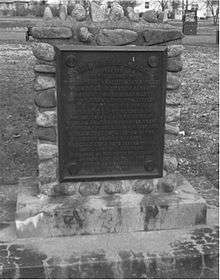Thomas Henry Barclay
Thomas Henry Barclay (12 October 1753 – 21 April 1830) was an American lawyer who became one of the United Empire Loyalists in Nova Scotia and served in the colony's government.[1]
Thomas Henry Barclay | |
|---|---|
| Speaker of the House of Assembly of Nova Scotia | |
| In office 1793–1799 | |
| Preceded by | Richard John Uniacke |
| Succeeded by | Richard John Uniacke |
| Member of the General Assembly of Nova Scotia for the Town of Annapolis | |
| In office 1793–1799 | |
| Preceded by | James De Lancey |
| Succeeded by | Phineas Lovett |
| Member of the General Assembly of Nova Scotia for Annapolis County | |
| In office 1785–1793 | |
| Preceded by | Phineas Lovett |
| Succeeded by | Thomas Millidge |
| Personal details | |
| Born | October 12, 1753 New York City, Province of New York, British America |
| Died | April 21, 1830 (aged 76) |
| Spouse(s) | Susan DeLancey
( m. 1775; |
| Children | 12 |
| Parents | Henry Barclay Mary Rutgers |
| Alma mater | King's College |
Early life
Thomas Henry Barclay came from a prominent New York family, the son of the Reverend Henry Barclay (1712–1764), an Anglican clergyman who served as rector of Trinity Church in New York City, and Mary Rutgers, the daughter of a wealthy brewer. His paternal uncle was merchant Andrew Barclay, who married Helena Roosevelt, granddaughter of Nicholas Roosevelt.[2]
After attending King's College (later Columbia University), he studied law with John Jay and was called to the bar in 1775.[1]
American Revolutionary War
Shortly after his marriage in 1775, his career was interrupted by the beginning of the American Revolutionary War. Barclay served with distinction, as a major, in the "Loyal American Regiment", in the British Loyalist forces, throughout the war and, with the confiscation of his New York property and having been named specifically in a Bill of Attainder in that state, he chose to join the loyalists heading to Canada.[1]
Resettlement in British Canada

After considering New Brunswick, Thomas Henry Barclay opted for Nova Scotia where the forces were given land grants. At one point, he had moved to Annapolis Royal and began a law practice.[1][3]
In 1785, he was elected to the 6th General Assembly of Nova Scotia representing Annapolis County while Edmund Fanning was governor. The next year, John Parr became governor. In 1793, Barclay was elected for Annapolis Township and served as speaker for the assembly. He also served as lieutenant-colonel in the colony's militia and was boundary commissioner for the British when the border between the United States and New Brunswick was settled in Jay's Treaty. Although he was appointed to the Council for Nova Scotia in 1799, he was given the post of British consul general in New York City later that year.[1][4]
Following the War of 1812, he became a member of another boundary commission dealing with another section of the border with the United States. In 1822, he settled at a country home on Manhattan.[1][5]
Personal life
In 1775, Thomas Henry Barclay married Susan DeLancey (1754–1837), a granddaughter of Stephen Delancey. Together, they were the parents of 12 children,[1] including:[6]
- Eliza Barclay (1776–1817), who married Peter Schuyler Livingston (1772–1809), the son of Walter Livingston, in 1796.[6]
- Henry Barclay (1778–1851), who married Catherine Watts (1782–1851), daughter of Robert Watts, in 1817.[6][7]
- DeLancey Barclay (1780–1826), who married Mary Fairfield, widow of Gurney Barclay, in 1825.[6]
- Maria Barclay (1782–1862), who married Simon Fraser in 1806.[6]
- Thomas Edmund Barclay (1783–1838), who married Catherine Smith Channing, daughter of Walter Channing, in 1821.[6]
- Susannah Barclay (1785–1805), who married Peter Gerard Stuyvesant (1777–1847), in 1803. After her death, he married Helena Rutherfurd.[8][9]
- Anne Barclay (1788–1869), who married William Burrington Parsons (1794–1869) in 1815. They were the grandparents of William Barclay Parsons.[10]
- George Barclay (1790–1869), who married Louise Matilda Aufrere (1792–1868), in 1818.[6]
- Anthony Barclay (1792–1877), who married Anna Matilda Waldburg (1795–1887), daughter of J. Bartholomew Waldburg, in 1816,[6] who took over as British Commissioner under the 6th and 7th articles of the Treaty of Ghent.[4]
- Henry Barclay (1794–1863), who married Sarah Ann Moore (1809–1873), daughter of Daniel Sackett Moore, in 1842. They were the parents of James Lent Barclay (1848–1925).[6]
Thomas Henry Barclay died there in 1830 and was buried in the Bowery.[6]
References
- Tulloch, Judith (1987). "Barclay, Thomas Henry". In Halpenny, Francess G (ed.). Dictionary of Canadian Biography. VI (1821–1835) (online ed.). University of Toronto Press.
- Bielinski, Stefan. "Henry Barclay". exhibitions.nysm.nysed.gov. Retrieved 27 October 2017.
- History of Annapolis Royal, p.344
- "Coll. 26 Barclay, Thomas, 1753-1830 Barclay collection ca. 1764-1893" (PDF). mainehistory.org. Maine Historical Society. Retrieved 27 October 2017.
- Rives, G. L. (1894). Selections from the correspondence of Thomas Barclay, formerly British consul-general at New York. New York: G. L. Rives.
- Moffat, R. Burnham (1904). The Barclays of New York: Who They Are And Who They Are Not,--And Some Other Barclays. R. G. Cooke. p. 116. Retrieved 27 October 2017.
- Shafer, Stephen. "A History of Trinity Episcopal Church, Saugerties New York: the First 130 Years". www.trinitychurchsaugerties.org. Trinity Episcopal Church, Saugerties, NY. Retrieved 27 October 2017.
- "Peter Gerard Stuyvesant (1778-1847)". www.nyhistory.org. New-York Historical Society. Retrieved 18 July 2017.
- Rutherfurd, Livingston (1894). Family Records and Events: Compiled Principally from the Original Manuscripts in the Rutherfurd Collection. De Vinne Press. p. 252. Retrieved 18 July 2017.
- Reynolds, Cuyler (1914). Genealogical and Family History of Southern New York and the Hudson River Valley: A Record of the Achievements of Her People in the Making of a Commonwealth and the Building of a Nation. Lewis Historical Publishing Company. p. 1316. Retrieved 14 August 2017.